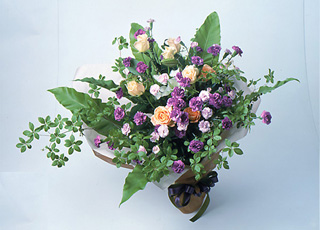Human Flower Project
Debating a Purple Carnation
Genetically-modified imports and crops are under much more intense public scrutiny in Europe than in the U.S. This week, EU ag leaders split over whether to admit another mauve novelty from Florigene.

Arrangement with genetically-modified purple carnations
Photo: Florigene
The European Union is not so unified when it comes to genetically modified crops. This past week EU agriculture ministers split on whether to allow imports of a GM rapeseed and a ghoulish strain of purple carnation concocted in Australia.
On the rapeseed question, ag representatives from 12 countries favored the import, 14 voted against, and Ireland abstained. Because EU countries’ votes are weighted, this outcome constituted a tie – and the matter will be decided by “the EU executive” – which appears to mean “permission granted.”
“Under EU rules, the EU’s executive European Commission now gains the legal power to issue a default authorisation. Since 2004, the Brussels-based Commission has approved a string of GM products, nearly all maize, in this way, outraging green groups.”
 Plant geneticist Benjamin Laga studies the DNA of rapeseed for Bayer CropScience
Plant geneticist Benjamin Laga studies the DNA of rapeseed for Bayer CropScience
Photo: Bayer Scientific Magazine
The Netherlands and England have been fairly non-committal on this issue. GM’s biggest opponents have been France and Germany, though Bayer CropScience, which developed the questionable rapeseed, is based in Germany.
Bayer’s T25, bred “to resist certain glufosinate-ammonium herbicides, was discontinued from commercial planting after the 2005 season. Only a small stock remains, in Canada, which could be exported to EU markets.” If approved, “remaining amounts of T25 rapeseed grown before 2005, imported from Canada and destined for use in food, animal feed and industrial processing” would be permitted for 10 years.
As for the flowers, the Moonaqua carnation comes from Florigene, which “developed the world’s first blue-coloured carnation in 1994.” Florigene has been giving roses and chrysanthemums the blues as well.
Take a look, and see what you think of the company’s purple-spectrum carnations. In many Latin American countries, purple flowers (“morenas”) are considered funereal, and these strike us as especially wake-worthy.
The Guardian reports, “Ironically, carnations were the EU’s last two authorisations of genetically modified (GMO) plants before it began its unofficial six-year moratorium on new GMO approvals.” Moondust, Moonshadow and Moonlite have already won EU approval. So what is it about their pale cousin, Moonaqua?

Florigene’s line of purple carnations: Moonaqua is on the right
Photo: Florigene
Speaking of irony, Jill Radsken writes for the Boston Herald that “carnations are back.” (This flower has long been horticulture’s equivalent of the Eagles – anyone and everyone’s loved hating them for so long that now, to denounce them makes you less a snob than a sheep.) Radsken divulges that florists have kept on smuggling carnations into arrangements, even over their sheeplike customers’ objections. “There is still a stigma to the flower,” admits New York floral boutique owner Sandra de Ovando, but she loves working with carnations, especially the deep purple varieties – most likely Frankenflowers from Florigene.
Florists are also trying to revive carnations because they’re longlasting and inexpensive, in the spirit of the times.
Along the same lines, we’ve read that global food shortages may be softening Europe’s hard line against genetically modified crops; the EU will be voting next month on whether to allow two types of GM maize to be grown on the continent. If passed these would be “the EU’s first approvals for GM crop cultivation since 1998.”


These purple hues will certainly elevate the lowly carnation (purple is my favorite color). I can see them now…in Easter bouquets.